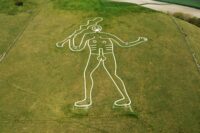 Snail shells have revealed that the Cerne Abbas Giant, the figure of a naked man sporting a club and a 30-foot phallus cut into chalk hillside in Dorset, is medieval at the oldest.
Snail shells have revealed that the Cerne Abbas Giant, the figure of a naked man sporting a club and a 30-foot phallus cut into chalk hillside in Dorset, is medieval at the oldest.
Martin Papworth, senior archaeologist at the National Trust, and environmental archaeologist Mike Allen said two species of snail that appeared for the first time in Britain in the Roman period – thought to have been brought over from France as food – were not found at the site.
However, microscopic species, found for the first time in the medieval period during the 13th and 14th Centuries, have been discovered in the samples.
“They arrived here accidentally, probably in straw and hay used as packing for goods from the continent,” Mr Allen said.
These remarkably content-rich snail shells also revealed changes in vegetation growth on the Giant over time. At some point the grass was allowed to grow over the chalk outline, but he was back to full potency by the Victorian period.
Cerne Abbas first appears on the historical record in the 17th century. A note in a November 4th, 1694, churchwarden record from St. Mary’s Church records three shillings spent “for repairing ye Giant.” Antiquarian interest in the Giant really picked up steam in the 18th century. John Hutchins wrote in The History and Antiquities of the County of Dorset (1774) that the Giant was said to have been cut by order of Lord Holles, then the owner of the land, perhaps as an obscene parody of Oliver Cromwell. Local old people, Hutchins reported, “averred it was there beyond the memory of man.” F. J. Darton wrote in English Fabric – A study of Village Life (1935) that the Giant was the work of farmers who banded together to keep soldiers from looting their properties during the Civil War. They had no firearms and so used clubs against would-be raiders. They cut the Giant as a symbol of their strength and resistance.
Renown archaeologist Sir Flinders Petrie surveyed the Giant in 1926 and concluded that it dated to the Bronze Age. His sole evidence was the presence of a nearby Bronze Age settlement. General Pitt Rivers, the owner of the Giant before he donated it to the National Trust in 1919, believed it was a Roman-era cult figure of Hercules with his club. Eighteenth century antiquarian Dr. William Stukeley was certain the Giant represented the “famous and first Hercules, the Phoenician leader of the first colony to Britain when they came hither for Cornish tin.” Other theories place its origin in the pre-Roman Iron Age, a representation of a Celtic god or the Anglo-Saxon god Helith/Helis.
We should find out just how wrong they were in a few months. Soil samples were taken from the giant’s elbows and feet in March are to be analyzed using optically stimulated luminescence (OSL), a technique that can determine when the minerals in the soil were last exposed to sunlight. The soil testing was delayed by the pandemic and results are now expected in the autumn. If all goes well, the OSL results will narrow down the date to a reasonably tight range.
I wonder if the giant’s mask is N95 rated.
Has the “microscopic species” properly been C14-dated or is it just an assumption that it arrived “for the first time in the medieval period during the 13th and 14th Centuries”, …and if so, have the snails been officially informed?
:confused:
His chest and nether parts remind me of a cat face.
OMG, Jane is right, this is a cat meme, way before the internet…